Two nights ago it snowed. They were thin and microscopic flakes. I let them fall on my jacket to watch them better. They were infinitesimal points. The most expert asserted that they were not carried by the wind, but new, just shaped. Right before sleeping, I looked out: there was a layer of 3 cm, light like a veil. The following morning there was no more sign of it, not even in the most sheltered places. Everything was like before, as if nothing had happened.
Since we were children, we learned to associate the idea of cold with that regarding snow; the colder it is the more abundant it snows. Then, at school you learn that Antarctica is the coldest continent of the world and in a moment you begin dreaming about how much snow it can fall there: 3, 5, 10, 100 metres of snow, insurmountable and massive walls by which you invent impossible exploits shortly before falling asleep in the rainy nights of March. The very moment of the year you have to put aside definitively the expectation for new snowfalls.
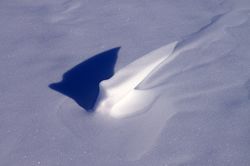 “In Antarctica that does not happen..” you think, “..in Antarctica children are always happy; they watch so much snow falling down!” But it is not so.
“In Antarctica that does not happen..” you think, “..in Antarctica children are always happy; they watch so much snow falling down!” But it is not so.
In Antarctica it falls far less snow than you usually think. On the coast a little more, but on the inland very little: the equivalent of 2,5 cm of water. It is surely less than that on the top of our Alps. What is very strange here is that snow, simply, does not melt.
Never.
Here the life of a snowflake does not resemble our home-grown snow. Instead, it is like the grains of sand in the desert. It falls, sure, but then it rises, thanks to very violent winds, it travels along boundless distances, beats against stones and rocks, frosting them like glass, it mixes with grains of sand, then, sometimes, it settles, in order to rise again and continue its pilgrimage.
Melting, a fancy, that is clear, but it can be entrapped and accumulated under other snow. At that moment it starts getting compact under the weight of overhanging snow, flakes get closer and the empty spaces reduce until, after about one thousand years and at about 80 m deep (Italian-French project EPICA), it becomes real ice, solid, very hard. That is its destiny, but only more immediate, as it has not come to an end yet.
Ice does not stay still; it moves radially from the centre to the exterior, just where it has to go: to the ocean, where else? But it arrives slow, very slow, in a surreal slowness, exasperating, irritating. Hundreds of thousands years. Hundreds of thousands….I do not know what you think about, but slowness arouses dread, awe, respect, much more than speed… slowness evokes the cosmos, that cannot be stopped. It manages to make useless and a little droll the rest, man and speed included.
Maybe proceedings here are like this, in this bubble where everything is broadened, expanded and where a simple cycle of light is spread on 365 days.
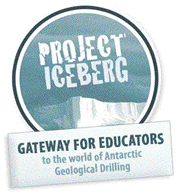



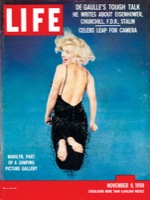 Have you ever met with those black and white photos shot during Marilyn Monroe’s visit to American troops in Vietnam? If it happens to you, take two minutes to look over them: she is wearing a short chenille jumper, she has got short and curly hair, a porcelain skin and a changing smile… all the requisites to be a Venus at that time and not only… The soldiers are fanning out around her, quite close to the photographer too, so that you can look at their faces: heads stretching in every direction, pale-blue, with short and very tidy hair, wide open eyes, emaciated but smiling faces.
Have you ever met with those black and white photos shot during Marilyn Monroe’s visit to American troops in Vietnam? If it happens to you, take two minutes to look over them: she is wearing a short chenille jumper, she has got short and curly hair, a porcelain skin and a changing smile… all the requisites to be a Venus at that time and not only… The soldiers are fanning out around her, quite close to the photographer too, so that you can look at their faces: heads stretching in every direction, pale-blue, with short and very tidy hair, wide open eyes, emaciated but smiling faces.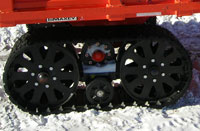 The antarctic equivalent of our buses, utes, undergrounds and motortrucks that we have use and fight daily. Have you ever guessed? Perhaps a new idea will raise from the environment and, why not, also from the men that built and now drive them.
The antarctic equivalent of our buses, utes, undergrounds and motortrucks that we have use and fight daily. Have you ever guessed? Perhaps a new idea will raise from the environment and, why not, also from the men that built and now drive them.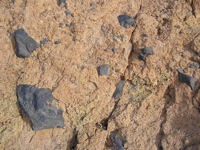 And we do well. The top is flat and without snow, the rock is brick red, porous and friable, with big fragments of black rock, many of which vacuolar. I pronounce the name Franco told me: ‘ialoclatsiti’. Probably, the fruit of a remote lave flow in the ice. We look around and we find nothing like what we have seen before.
And we do well. The top is flat and without snow, the rock is brick red, porous and friable, with big fragments of black rock, many of which vacuolar. I pronounce the name Franco told me: ‘ialoclatsiti’. Probably, the fruit of a remote lave flow in the ice. We look around and we find nothing like what we have seen before. “In Antarctica that does not happen..” you think, “..in Antarctica children are always happy; they watch so much snow falling down!” But it is not so.
“In Antarctica that does not happen..” you think, “..in Antarctica children are always happy; they watch so much snow falling down!” But it is not so.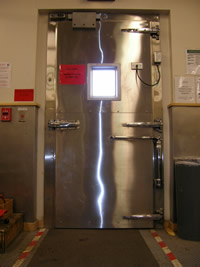 Yesterday it was -29°, without considering the wind. I look for a sign letting you know, the clearest way, what means lesstwentyninedegrees and I find it at once: the doors! I think you recognize something familiar in the photo. Have you ever entered the kitchen of a restaurant or the backs of some butchers’ shops? No? Well, try; you will find cold stores. Places for the preservation of food at several degrees. About twenty years ago in every house there were freezers with a hook. They are still trendy and you can find them in some glamour houses on retrò freezers. Here in Antarctica the doors are like those ones. And I assure you they are not there for show.
Yesterday it was -29°, without considering the wind. I look for a sign letting you know, the clearest way, what means lesstwentyninedegrees and I find it at once: the doors! I think you recognize something familiar in the photo. Have you ever entered the kitchen of a restaurant or the backs of some butchers’ shops? No? Well, try; you will find cold stores. Places for the preservation of food at several degrees. About twenty years ago in every house there were freezers with a hook. They are still trendy and you can find them in some glamour houses on retrò freezers. Here in Antarctica the doors are like those ones. And I assure you they are not there for show.